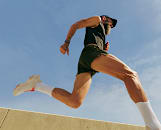
LaylaBird / E+ via Getty Images
5 Science-Backed Benefits of Working Out with Friends
Exercising together can boost performance and reduce fatigue, among other health perks. Here’s why—and how to maximize these gains.
By Jenny McCoy•
5 Key Advantages of Working Out with Friends
How to Work Out with Friends
Are There Any Drawbacks to Working Out with Friends?
The Takeaway
In a perfect world, you’d probably be stoked to slip on sneakers and break a sweat every day. But for many exercisers—even the diehards—that’s just not the case. Sometimes that’s because our calendars are too packed, and other times, it’s because we simply can’t find the motivation to move. Luckily, there’s a simple hack that can help with the latter: Working out with friends.
Discover more ways to reach your goals with Peloton
5 Key Advantages of Working Out with Friends
Research shows exercising with friends can help you stick with a workout program while also providing a ton of other compelling benefits, many of which apply even if you’re not in the same physical space. Having a workout buddy isn’t just about making movement more fun (although that’s an undeniable plus). There are a lot of positives to PRing with others, including some you might not expect. Here’s what experts—and science—have to say.
1. Increased Accountability
You have the best intentions of making that 6 AM Pilates class, but when the hour arrives and you’re snuggled up in bed, hitting snooze wins. Here’s where having an accountability partner can make it harder to bail on your own plans.
“If you’re skipping a workout, you’re not just letting yourself down—there’s also someone else in the mix,” says Susie Reiner, PhD, postdoctoral researcher at the University of Kentucky’s Sports Medicine Research Institute. In that sense, having a fitness accountability partner can “increase your commitment to your workout sessions throughout the week,” Reiner says.
Research backs this: A small 2020 study of nine romantic couples, published in the Journal of Racial and Ethnic Health Disparities, found that those who exercised together logged an average of 20 more minutes of weekly activity than those who went at it solo. Of course, your workout partner doesn’t have to double as your significant other in order to reap this benefit. Simply having company on, say, leg day, can be helpful.
2. Friendly Competition
Enlisting an exercise partner can spur you to work harder than you would on your own. This is known as the Köhler effect, Reiner says.
“When you work out with others—particularly in a pair—there’s a competitive atmosphere. You’re more apt to be motivated and increase your performance when you know that someone else is also trying to do the same thing,” she explains.
Research shows the Köhler effect comes into play even for virtual training partners. A 2023 study co-authored by Reiner, published in the journal Physical Activity and Health, found that when people used virtual fitness platforms, purely knowing that others were taking the class at the same time boosted motivation. (Any Peloton Member who’s ever sneaked a peek at the Leaderboard can vouch for the sense of camaraderie it provides.)
This perk is most effective when the competition is truly friendly. If you’re feeling inadequate or experiencing another negative impact during your group training sessions, Reiner suggests doing some self-reflection and self-encouragement to see if you can work through those feelings. Remember, you have your own genetics and fitness journey, she says, not to mention reasons why you lace up. Working toward a new PR? Regaining speed from an injury? Getting stronger to chase after the kids? Everyone has a different reason and being clear on that will hush your comparing mind.
3. Built-In Bonding Time
Regularly working out with friends can be an excellent way to sustain and even fortify social bonds. In a 2022 study published in Applied Psychology: Health and Well-Being, researchers surveyed groups of teens who completed a two-day, 55-mile orienteering challenge. According to study co-author Arran Davis, PhD, a postdoctoral researcher at the Centre for the Study of Social Cohesion at the University of Oxford, the groups that felt like they relied on each other more and cooperated more felt closer to each other after the challenge. This, in turn, improved their overall wellbeing.
4. It Can Help You Chill Out
Not only can exercising with others help you physically turn it up in your next Tabata class, but it can also help you mentally dial it back for the better. In a 2017 study published in the Journal of Osteopathic Medicine, subjects who regularly participated in group fitness classes significantly decreased their perceived stress compared to those who sweated it out solo or skipped the gym entirely.
5. It Decreases Loneliness
Despite how connected our world is today, an increasing number of adults feel lonely. Sweating it out with a friend is a simple way to combat that: A 2020 study of older adults published in the American Journal of Geriatric Psychiatry concluded that participating in community-based group health classes (like tai chi and exercise for arthritis) helped subjects reduce their feelings of loneliness and social isolation.
How to Work Out with Friends
Now that you know how much you can gain from working out with friends, let’s talk about how to realistically make that happen.
Align On Your Goals
Almost nothing beats the euphoria of high-fiving your best friend after you cross the finish line of your first half marathon together, which is why Reiner suggests enlisting a friend who’s got similar fitness interests. Working toward a common goal together is a great way to bond, encourage each other, and stay motivated to push yourself a little further each day.
For example, if you’re really into yoga, enlist someone who is already a regular at your studio. Or if you routinely wave to your neighbor who’s out jogging at the same time you are, ask them to join you for a run next time.
Figure Out What Kind of Schedule Is Realistic for You
Ever seen that meme: “Adult friendship is basically two people saying ‘I haven’t seen you in forever, we should get together,’ over and over until one of them dies?” There’s a reason that joke resonates so strongly with people. Trying to coordinate multiple schedules is a Herculean effort, which is why Peloton Member Marissa Sturm typically shares her weekly workout plan in advance with friends, giving them the option to join if it works for them. That way, she explains, “it doesn’t feel as forced.”
For friends with busy schedules, she’ll propose a workout as a way to get quality time together and check the box for fitness. “Instead of getting coffee or lunch with a friend, I'll say, ‘Do you want to do a class together?’” she says. “People are always down to do that.”
And if you find yourselves really struggling to make the scheduling work, try taking your workout online and becoming virtual workout buddies instead. For example, you could both agree to complete the same workout but on your own time, and then text each other afterward to celebrate.
Ensure Your Fitness Levels Mesh
Some exercisers find it motivating to work out with people who are way more fit than them. Others? Not so much. If you’re in the latter camp, make sure your workout partners are close to your ability level (or maybe slightly above) so you don’t feel discouraged or fall into the comparison trap,Reiner says.
Make It Fun
This way, you actually want to do it. Aim to inject humor and excitement wherever you can, whether that’s ending a run at the new bakery, wearing matching tops to a dance class, or sending a high five during class to cheer each other on in real time. Sturm, for her part, has found friends are more eager to join her for workouts that have musical themes.
Collaborate Where Possible
The more collaborative and interactive your partner or group workouts are, the more likely you are to feel the positive effects of that social connection, Davis says. Small things, like taking turns picking which workout to do next or listening to music together versus popping in headphones, can make a huge difference.
Be Patient with the Process
Not every friend is going to make a great workout partner—and that’s OK. Don’t get discouraged if it takes time to find the right person (or group of people) that gels with your interests, goals, and preferences. “You just have to keep trying different groups, areas, modalities of exercise to find where your niche is,” Reiner says.
Are There Any Drawbacks to Working Out with Friends?
Though there are many legitimate benefits of working out with a friend, there are also some possible cons.
One is that a mismatch in commitment levels can be dispiriting. If your workout buddy is not as motivated as you—for example, you show up to a planned gym session only to discover they’ve bailed—that can be very discouraging, Reiner says. Combat this by recognizing you’re ultimately still in charge of your exercise journey, she says. Know that the “right” workout partner for you may shift with time, she adds, and that’s not a bad thing.
On the flip side, if you’re hitting it off so well with your fit friend that you spend more time gabbing than actually exercising, that can also be counterproductive. In that case, Reiner suggests establishing boundaries. For example, allow yourselves a certain amount of time to chat and then commit to focusing on your workout. Afterward, if you both have time, pick up where you left off at a nearby coffee shop.
The Takeaway
Working out with friends is a proven way to bond and feel like you’re a part of something bigger than yourself. The best part? You can get many of these benefits from virtual sessions, which makes it easy for the at-home exerciser to reap all the awesome perks too.
Not sure where to start? Check out Peloton’s teams feature, which offers simple ways to connect with thousands of Peloton Members. This can help you find the community you need to reach your goals in fitness—and beyond.

Peloton App
Access thousands of classes with no equipment needed.
This content is for informational and educational purposes only and does not constitute individualized advice. It is not intended to replace professional medical evaluation, diagnosis, or treatment. Seek the advice of your physician for questions you may have regarding your health or a medical condition. If you are having a medical emergency, call your physician or 911 immediately.
Strengthen your mind-body connection
Enter your email to get articles, expert-backed tips, and updates from Peloton sent to your inbox.
By providing your email address, you agree to receive marketing communications from Peloton.
For more about how we use your information, see our Privacy Policy.












